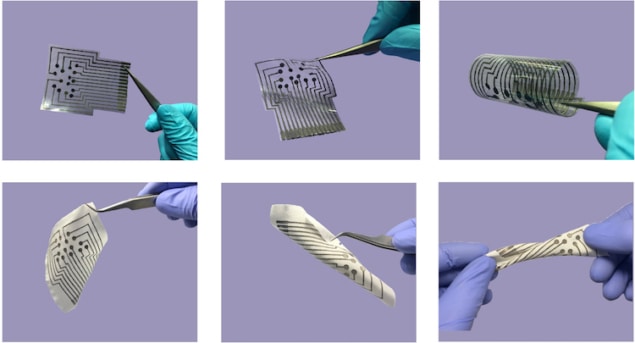
A semi-flexible patch made from a silk-derived carbon material is as accurate as commercial high-performance mass spectrometers at detecting certain biomarkers in sweat, say researchers in China. Although the device still needs to be optimized, its developers at Tsinghua University in Beijing and Northwest University in Xi’an have demonstrated that it can detect the biomarkers in real time. It could thus be used to monitor health, and perhaps even to detect certain diseases.
Sweat contains various health-related biomarkers, including ascorbic acid, uric acid, metabolites like glucose and lactate, and electrolytes such as Na+ and K+. It is therefore an attractive, less-painful alternative to blood samples for assessing a patient’s health. In recent years, various groups have developed flexible and wearable sweat sensors that can monitor these biomarkers in real time, and researchers have made much progress with colorimetric, electrochemical and fluorescence sensors. However, many of these devices are rigid and difficult to manufacture, and the electrode materials they contain (such as gold, silver, metallic oxides and graphene) are poor conductors of electricity.

Electrodes made from a silk-derived intrinsically N-doped carbon material
Now, a team led by Yingying Zhang at Tsinghua University has fabricated a sweat analysis patch based on an array of electrodes made from a flexible, silk-derived intrinsically N-doped carbon material. This textile has a good wetting ability, meaning it collects sweat efficiently.
The researchers used laser scribing to fabricate flexible conductive circuits from the sensor array. They then integrated six electrochemical sensors into the array and modified the electrodes with different functional materials so that they could selectively detect multiple biomarkers. The last step in the process involved integrating the patch with a signal collection and transmission circuit component to make a wireless, on-body and real-time sweat analysing device.
Six biomarkers measured simultaneously
Zhang and colleagues measured the concentration of six biomarkers (glucose, lactate, ascorbic acid, uric acid, Na+and K+) by recording the corresponding electrochemical current and voltage response of the electrodes while the patches were fixed to the skin of five healthy 20- to 30-year-old human volunteers. The volunteers cycled for 30 minutes, and the researchers say they were able to continuously – and simultaneously – detect all six biomarkers with a high degree of precision. Indeed, their results were comparable to those obtained using commercial high-performance liquid-chromatography mass spectrometry (HPLC-MS). Such high sensitivity is required to capture the small but physiologically relevant fluctuations in the concentrations of bio-analytes, which normally remain within a narrow range, Zhang explains.
“The wealth of information present in sweat could potentially indicate the body’s deeper biomolecular state,” she tells Physics World. “It could thus be used in health monitoring applications to detect health risks such as diabetes, for example.”

Wearable patches could ‘decode’ sweat
In a commercial version of the device, the results of these measurements could be displayed on a mobile phone screen, although Zhang cautions that there is still much work to be done. At 100 microns thick, the patches are relatively bulky (a thickness of less than 10 microns is required), and they cannot be stretched. This makes them sensitive to noise from strain motion – especially at the interface between human skin and the electronics part of the sensor.
The team report their work in Science Advances.



